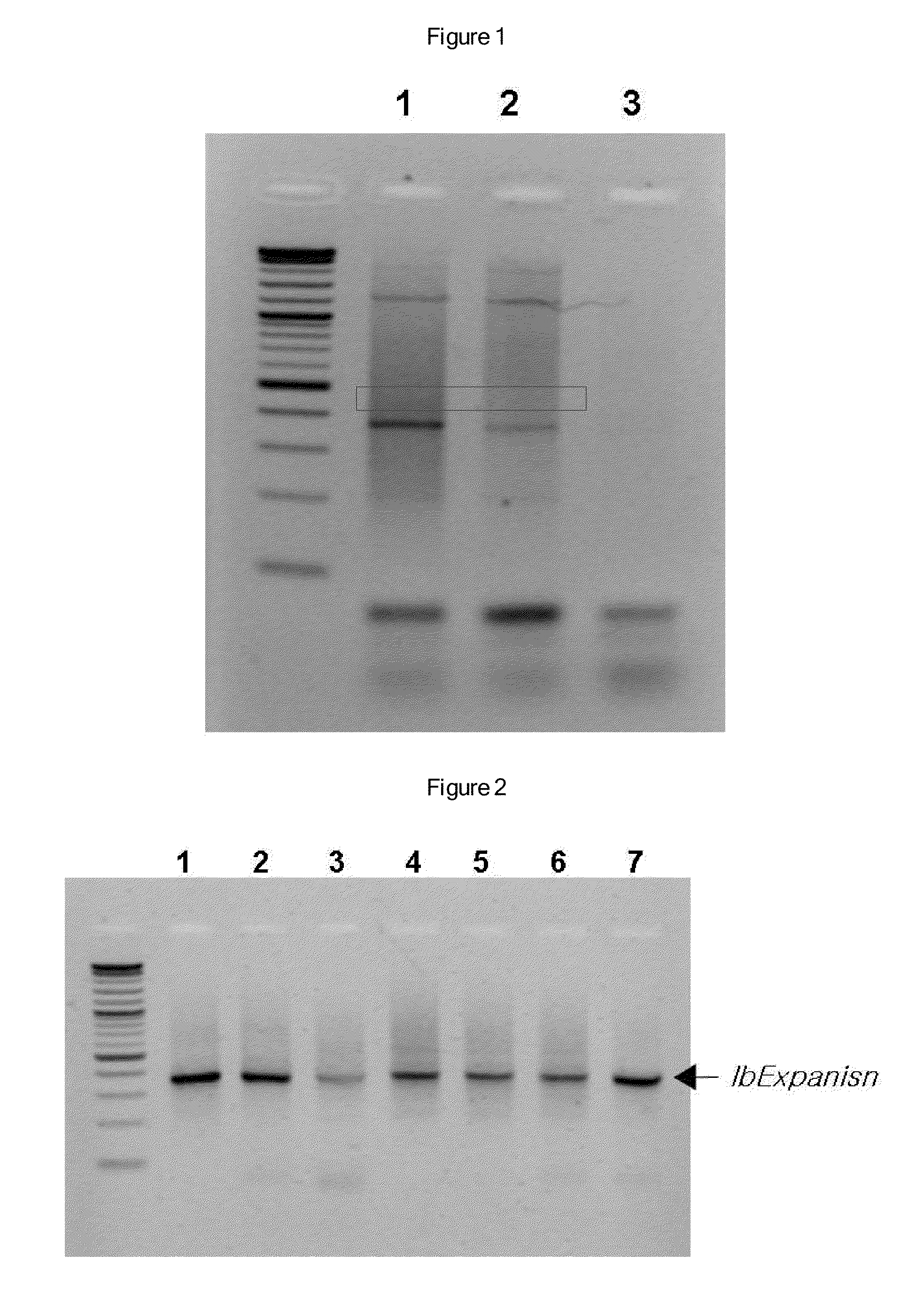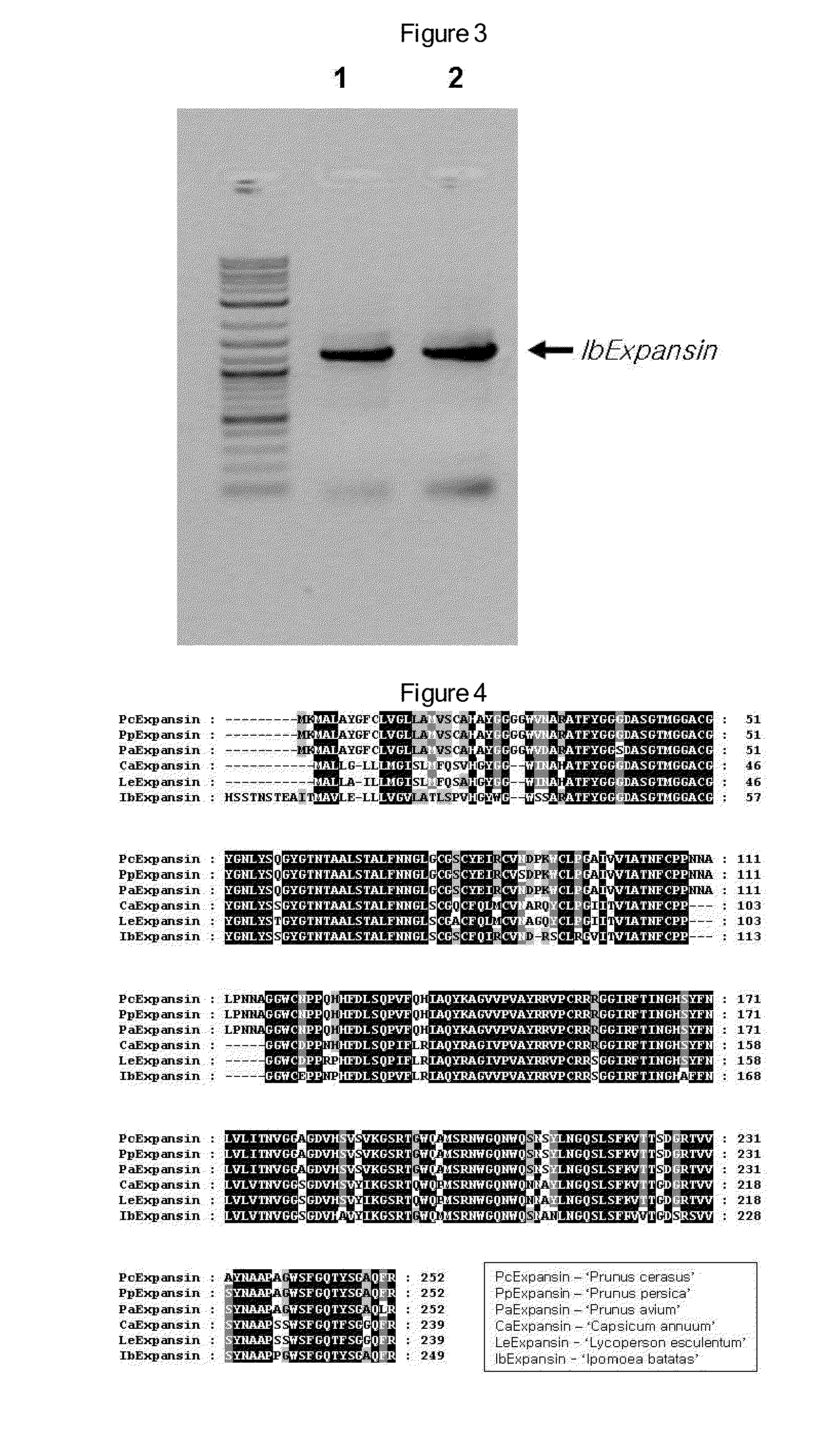Antisense DNA of Sweetpotato Expansin cDNA and Method For Increasing Storage Root Yield Using The Same
a technology of expansin and cdna, which is applied in the field of anti, can solve the problems of little research on the molecular mechanisms of storage root production, inability to bear seeds of transgenic rice plants, and difficult monitoring of storage root growth, so as to accelerate the growth of storage root, suppress the elongation growth of roots, and high production
- Summary
- Abstract
- Description
- Claims
- Application Information
AI Technical Summary
Benefits of technology
Problems solved by technology
Method used
Image
Examples
example 2
Sequencing and Analysis of Nucleotide Sequence of Full-Length IbExpansin
[0056]A 1.2 kb full-length cDNA was cloned by PCR and inserted into a pGEM-T Easy vector, which was then amplified. Sequencing analysis revealed that IbExpansin is 1,213 bp long and consists of a 33 bp 5′-UTR, a 717 bp ORF, and a 463 bp 3′-UTR. This full-length IbExpansin cDNA was registered in NCBI, with Accession No.: DQ515800. The IbExpansin amino acid sequence, consisting of 238 amino acid residues, is highly conserved, with the exception of the N-terminal region (FIG. 4), and shares homology as high as 78% with expansin amino acid sequences of tomato and pepper (FIG. 5).
example 3
Northern Blot Analysis of Tissues
[0057]1. Northern blotting
[0058]The expression pattern of IbExpansin was examined with various tissues at various developmental stages through Northern blotting.
[0059]For the isolation of total RNA, roots, stems, leaves and petioles of sweetpotato at various developmental stages were used as RNA sources. That is, total RNA was isolated from tissues in a non-storage root stage, such as roots (FRN: fibrous root in non-storage root stage), stems (stem-FRN), leaves (Leaf-FRN) and petioles (petiole-FRN); tissues in an early storage root stage, such as roots (fibrous root in early storage root stage, FRES); tissues in a storage root stage, such as roots (SR), stems (Stem-SR), leaves (Leaf-SR) and petioles (Petiole-SR); and tissues in a late storage root stage, such as roots (fibrous root in late storage root stage, FRLS) (FIG. 6). Total RNA extraction was performed using a 4.4 M guanidinium-SDS lysis buffer (Chirgwin et al., 1979) / 5.7 M CsCl gradient metho...
example 4
Construction of Binary Vector
[0065]A 5′ primer (SEQ ID NO.: 10) was synthesized with KpnI restriction site and a 3′ primer was synthesized with BamHI restriction site to construct a knock-out binary vector. PCR was performed with the primers to obtain a full-length IbExpansin (NCBI accession number: DQ515800) cDNA. The PCR product was inserted into a pGEM-T Easy vector, and digested the pGEM-T Easy vector with BamHI and KpnI to excise the cDNA therefrom. The cDNA digest was inserted in the antisense direction between a CaMV35S promoter and an NOS terminator in a pMBP1 vector to construct the binary vector pIbExpansin-anti (FIG. 9). The insertion was confirmed by colony PCR and restriction enzyme digestion (FIG. 8)
PUM
| Property | Measurement | Unit |
|---|---|---|
| Antisense | aaaaa | aaaaa |
Abstract
Description
Claims
Application Information
 Login to View More
Login to View More - R&D
- Intellectual Property
- Life Sciences
- Materials
- Tech Scout
- Unparalleled Data Quality
- Higher Quality Content
- 60% Fewer Hallucinations
Browse by: Latest US Patents, China's latest patents, Technical Efficacy Thesaurus, Application Domain, Technology Topic, Popular Technical Reports.
© 2025 PatSnap. All rights reserved.Legal|Privacy policy|Modern Slavery Act Transparency Statement|Sitemap|About US| Contact US: help@patsnap.com



